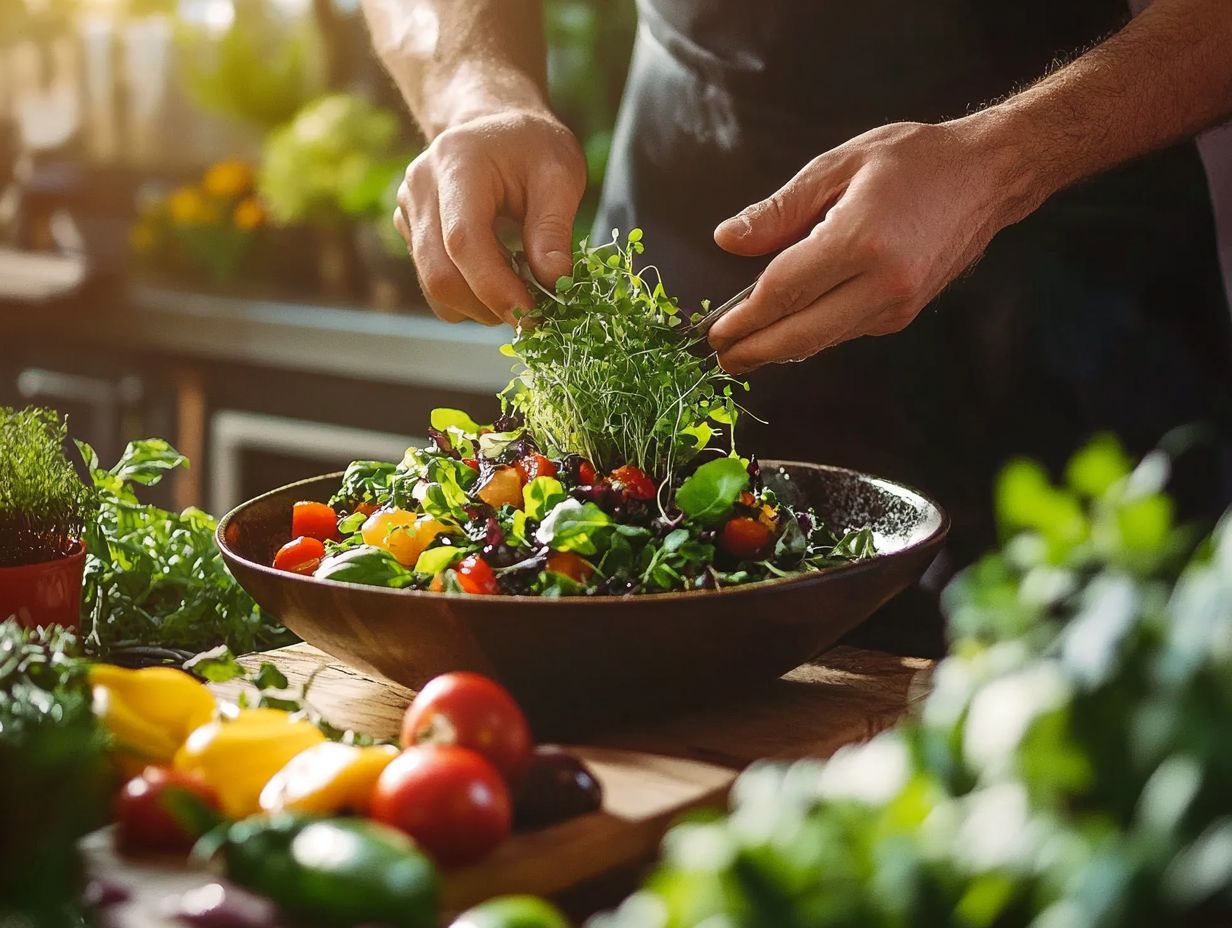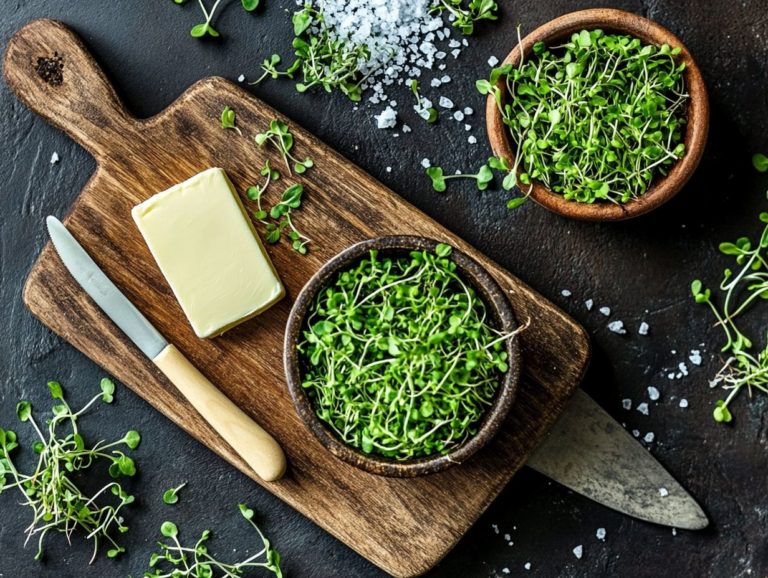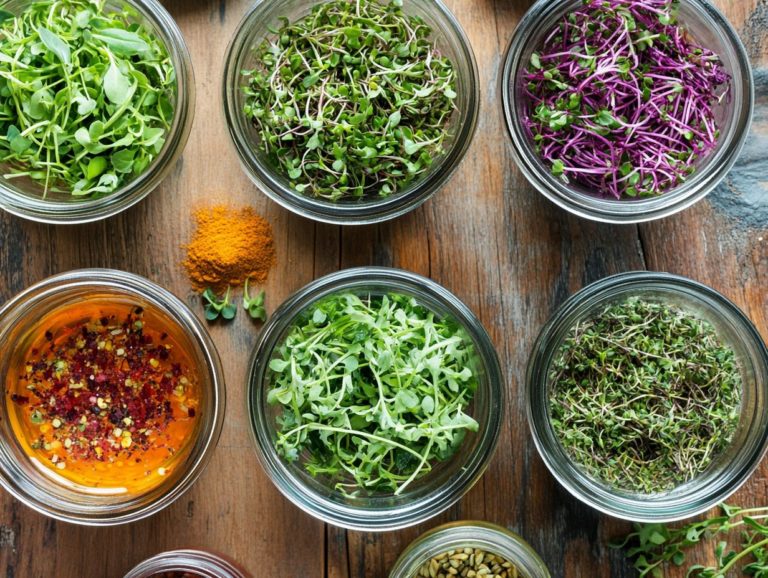35. How to Incorporate Microgreens in Cooking
Microgreens have emerged as a standout trend in the culinary arena, celebrated for their vibrant colors and remarkable nutritional benefits.
This article delves into the advantages of microgreens, highlights popular varieties, and provides a guide on how to cultivate them right in your own home.
You ll discover inventive ways to incorporate these nutritious greens into your meals, along with expert tips on selecting and storing them to ensure peak freshness. Prepare to take your cooking to new heights with these delightful greens!
Contents
- Key Takeaways:
- Types of Microgreens
- How to Grow Microgreens at Home
- Incorporating Microgreens in Different Dishes
- Tips for Buying and Storing Microgreens
- Frequently Asked Questions
- 1. Curious about microgreens? Here s what you need to know!
- 2. Can I use microgreens in place of regular greens in recipes?
- 3. How should I store microgreens to keep them fresh for longer?
- 4. Can I grow my own microgreens at home?
- 5. What are some creative ways to use microgreens in cooking?
- 6. Are there any specific types of microgreens that are best for cooking?
Key Takeaways:
- Enhance both nutrition and flavor by incorporating microgreens in your cooking.
- Experiment with varieties like basil and radish for different tastes.
- Grow microgreens at home to ensure freshness and quality.
What are Microgreens?
Microgreens are young, edible plants harvested at an early stage, typically reaching heights of just 1-3 inches. These little wonders are nutritional powerhouses, often hailed as superfoods, which are nutrient-rich foods considered especially beneficial for health. Not only are they visually stunning, but they also offer a delightful array of vibrant flavors that can elevate your culinary creations. To enhance your dishes even further, check out this guide on how to pair microgreen varieties with dishes.
Their versatility allows you to incorporate microgreens into salads, sandwiches, and even as a sophisticated garnish, transforming each dish into a gourmet experience. For tips on how to use these ingredients effectively, check out cooking with microgreen varieties. With hues ranging from deep purples to lush greens, these miniature plants are loaded with essential vitamins, minerals, and antioxidants.
Microgreens frequently boast higher nutrient concentrations than fully grown counterparts. Both chefs and home cooks cherish their ability to add texture and a burst of flavor to soups, tacos, and wraps. You can effortlessly blend them into smoothies or use them as toppings for gourmet pizzas, providing an exciting way to enhance your meals with nutrition without sacrificing flavor. To learn more about these delicious greens, check out this guide on how to grow your favorite microgreen varieties.
Whether enjoyed raw or lightly cooked, they not only boost the taste but also enhance a dish’s visual appeal, making your meals healthier and irresistibly enticing.
Benefits of Incorporating Microgreens in Cooking
Incorporating microgreens into your cooking can elevate both the flavor and nutritional profile of your meals, making them an exceptional choice for anyone dedicated to a healthy lifestyle.
These petite greens are packed with nutrients, brimming with vitamins, minerals, and antioxidants that offer a myriad of health benefits, enhancing the overall quality of your diet. Whether you re whipping up savory dishes or blending refreshing smoothies and juices, microgreens seamlessly infuse your meals with vibrant nutrition, transforming everyday fare into delightful and healthful options.
Nutritional Value and Flavor Boost
The nutritional value of microgreens is truly remarkable; they often pack a more potent punch of vitamins and minerals compared to their mature counterparts, boasting essential nutrients like vitamins C, E, and K, along with zinc and iron. Incorporating these tiny powerhouses into your diet is an excellent way to elevate your meals with nutrient-dense ingredients.
Microgreens bring a unique flavor boost, introducing distinct profiles that can transform ordinary dishes into vibrant culinary masterpieces. Research reveals that varieties like broccoli, radish, and sunflower microgreens can contain up to 40 times more nutrients than their fully grown versions. This impressive concentration of phytochemicals—natural compounds found in plants that provide health benefits such as antioxidants and fiber—not only supports your overall health but also enhances digestion and immune function. Discover more about the microgreen varieties and their culinary uses to elevate your cooking.
Culinary enthusiasts frequently turn to these petite greens to elevate salads, sandwiches, and garnishes, infusing their dishes with fresh, peppery notes that enhance both taste and presentation. The versatility of microgreens allows you to experiment in the kitchen, ensuring that even the simplest meals benefit from increased nutritional value and an exciting flavor profile.
Join the microgreens movement today and elevate your culinary skills!
Types of Microgreens

You ll discover a myriad of microgreens. Each one presents unique flavors and cooking uses, making them a splendid addition to your kitchen arsenal.
Think of popular varieties like Basil, Wheatgrass, and Dragon-Fruit Kale. They don t just bring vibrant colors to your dishes; they also offer distinctive flavor profiles that can elevate a simple microgreen salad into a gourmet delight.
By incorporating these extraordinary ingredients into your culinary repertoire, you ll not only enhance your cooking skills but also inspire yourself to create innovative recipes that truly tantalize the taste buds!
Popular Varieties and Uses
Among the popular varieties of microgreens, you ll find Basil, Jalapeno Wasabi Mustard, and Wheatgrass. Each adds its own unique twist to your dishes, whether they lean savory or sweet.
These vibrant greens also deliver a nutritional boost and introduce distinct flavors that can elevate your everyday meals. For instance, the sweet and aromatic notes of Basil can transform your pesto or caprese salads into something truly delightful.
On the other hand, the fiery Jalapeno Wasabi Mustard offers a bold enhancement to tacos or potato salads that will leave your taste buds tingling.
Wheatgrass, with its subtly sweet profile, can elevate your smoothies, blending seamlessly with fruits to create refreshing drinks. These microgreens are not just ingredients; they re an invitation for you to experiment in the kitchen!
Turn simple dishes into culinary masterpieces that impress.
How to Grow Microgreens at Home
Growing microgreens at home is not just a rewarding gardening endeavor; it s also a simple way to elevate your meals with fresh ingredients!
These vibrant greens grow well even in small spaces and demand minimal investment. This makes them perfect for both novices and experienced gardeners.
With the right care, grow homegrown wheatgrass and various microgreens. This enriches your culinary creations with flavorful greens that boost both the taste and nutrition of your dishes.
Step-by-Step Guide
To grow microgreens at home, follow a few straightforward steps: select the right seeds, prepare your growing medium (the soil or material in which plants grow), and ensure optimal light and water conditions.
With an array of easy recipes and flavorful dishes at your disposal, incorporating microgreens into your meals will infuse a burst of freshness into your culinary creations! This step-by-step guide empowers you to cultivate your own microgreens successfully, providing a continuous supply of nutritious greens for a healthy lifestyle.
Start by choosing seeds like arugula, basil, or radish, all celebrated for their rapid growth and vibrant flavors. Next, opt for a soil mix or coconut coir as your growing medium; it retains moisture while delivering essential nutrients.
Once you ve sown your seeds about half an inch apart, place them in an area that receives at least six hours of indirect sunlight or utilize grow lights to boost their growth. Water them gently with a spray bottle to avoid displacing the seeds.
Monitor their progress daily. When they reach approximately two inches in height, it s time to harvest.
These microgreens are perfect for garnishing salads or adding to sandwiches, and you can explore ways to enhance flavor in microgreens, making nutritious eating both accessible and delicious!
Incorporating Microgreens in Different Dishes

Incorporating microgreens into your dishes can truly elevate your cooking. They provide a versatile and nutritious option for enhancing your meals.
Imagine unique recipes that infuse microgreens into sweet peach tea or savory dishes adorned with these vibrant edible garnishes the possibilities are truly limitless!
By experimenting with various cooking techniques, you can craft delightful treats that not only tantalize the taste buds but also support a healthy lifestyle. Transform every meal into an exciting culinary adventure!
Start your microgreen garden today for fresh, flavorful meals every day!
Recipes and Ideas
Creative recipes featuring microgreens can make your meals taste amazing. Imagine incorporating them into an acai bowl or enhancing fresh fruit roll-ups. You can also craft a vibrant microgreen salad or indulge in unique treats like superfood pudding. These treats not only delight your taste buds but also boost nutrition perfect for the health-conscious eater.
Beyond their versatility, microgreens like arugula and radish bring a peppery kick to any dish. Nutrient-dense varieties such as sunflower and pea shoots offer a subtly sweet crunch that’s hard to resist. To learn how to incorporate microgreens into your diet, try blending them into a creamy herb dip that pairs beautifully with fresh veggies.
Microgreens make your dishes pop with color and flavor! They enhance the presentation and taste of savory meals, like a hearty grain bowl topped with micro basil and kale, delivering essential vitamins and antioxidants in every delicious bite. If you’re interested in growing them yourself, check out this guide on how to grow microgreens for a fresh salad.
Tips for Buying and Storing Microgreens
When buying and storing microgreens, a few essential tips can elevate their freshness and quality, ensuring you always have these nutritious gems on hand for your meals.
Fresh microgreens can often be sourced at local farmers’ markets or specialty grocery stores, but cultivating your own at home yields the best flavor and nutritional benefits.
Mastering the art of proper storage empowers you to whip up healthy snacks while preserving their distinct flavors as long as possible.
Maximizing Freshness and Quality
To truly maximize freshness and quality when purchasing microgreens, always seek those vibrant colors and crisp textures these are indicators of fresh ingredients. Proper storage is crucial in preserving their nutritional value and flavors. Keep them in a cool, dry place or refrigerate them to ensure they remain as nutrient-dense as possible. By following these guidelines, you can enjoy delicious microgreens that contribute to a healthy lifestyle and enhance your meals.
When selecting microgreens at the store, inspect for any signs of wilting or discoloration; these are telltale signs that they may not be at their peak quality. For optimal storage, use a breathable container to allow airflow, which helps prevent moisture build-up. If you’re interested in growing your own, check out this guide on how to grow microgreen varieties in your kitchen.
Incorporating fresh microgreens into your dishes doesn’t just elevate the flavors; it also adds essential vitamins and antioxidants. For those looking to grow their own, you can follow a step-by-step guide to sowing microgreens. Their unique textures and tastes can transform simple salads, sandwiches, and smoothies into nutrient-packed culinary masterpieces, making them a versatile ingredient for anyone passionate about cooking.
Frequently Asked Questions

1. Curious about microgreens? Here s what you need to know!
Microgreens are young vegetable greens harvested just after their first set of true leaves. They are packed with nutrients and add flavor, texture, and color to dishes. You can easily incorporate them into cooking by adding them as a garnish, mixing them into salads, or using them in various recipes.
2. Can I use microgreens in place of regular greens in recipes?
Yes, you can use microgreens instead of regular greens in recipes. However, keep in mind that their flavor and texture may differ from mature counterparts. It’s best to experiment and adjust the amount based on your personal preference.
3. How should I store microgreens to keep them fresh for longer?
The best way to store microgreens is to keep them in an airtight container or ziplock bag in the refrigerator. Make sure to remove any excess moisture before storing them. They should stay fresh for up to a week.
4. Can I grow my own microgreens at home?
Yes, you can easily grow your own microgreens at home. Purchase microgreens growing kits or use a shallow container with good quality potting soil. Follow the instructions provided with the kit or research online for the best growing conditions for the specific microgreens you want to grow.
5. What are some creative ways to use microgreens in cooking?
Microgreens add flavor and nutrition to many different dishes. Use them in sandwiches, wraps, soups, smoothies, or as toppings on pizzas and omelets.
Experiment with using them in sauces, marinades, and dressings for a delicious twist.
6. Are there any specific types of microgreens that are best for cooking?
There isn’t a single best type of microgreen for cooking; it all comes down to personal preference. Popular choices include broccoli, kale, radish, and sunflower microgreens.
Dive in and try various types to discover your favorites in your dishes!






